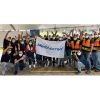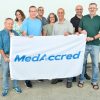Q: We need to make a low-volume enclosure for a medical device with annual quantities of 1000. Most of our experience has been with injection molded enclosures, but the tooling cost is prohibitively high for the volumes under consideration. What alternative processes might be available, and what are the advantages and disadvantages of each?
A: There are many processes that might be contenders, but among the most attractive are the following:
Thermoforming: A sheet of thermoplastic material is heated and then draped over or even somewhat pushed into a mold. A vacuum is then created on the mold side and the air between the mold and plastic is evacuated through small air vents. This sucks the plastic up tightly against the mold, creating the final part shape. The tooling is just a fraction of the cost of injection molds and undercuts are relatively inexpensive to make. However, the part design is more limited than in injection molding—ribs and bosses are difficult or impossible to make; the part thickness varies since only the mold side of the part is held to tight dimensional tolerances; and the molded surface can only have about three times the area of the unmolded sheet.
Reaction injection molding (RIM): In this process, the ingredients for the polymer are mixed just before they are injected into the mold. Initially, the mixture has low viscosity and easily fills the mold before the reaction between the base ingredients creates the actual polymer. The materials are fairly limited, but do include nylon among some others. Advantages include very reasonable tooling cost; less concern about thick sections and sink marks than with injection molding; and elimination of weld lines since the flow fronts mix before polymerization occurs. The process is slow compared to injection molding and vendors in the USA are not as common as injection molding vendors.
Sheet metal: Many low-volume enclosures are made from sheet metal because the tooling cost is very low for a basic shape. The tradeoff is that you lose the ability to easily integrate highly contoured industrial design, and the enclosures typically have a blocky appearance.
Carbon fiber: This material has amazing properties, but along with these properties, it has an amazingly high price. It is lightweight, stiff and strong, and it has low thermal expansion. However, each part is made by painstakingly laying strips of epoxy-impregnated carbon fiber around a mold, and then curing the part. The process is slow and labor-intensive, plus the material cost is high. Although expensive, this could be a good option for portable equipment, where weight is a concern.







